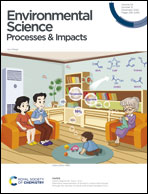Identification of chlorinated products from tyrosine and tyrosyl dipeptides during chlorination: a computational study†
Abstract
Chlorinated amino acids and peptides, as the model modified protein structures relevant to pathogen inactivation and an emerging class of disinfection byproducts (DBPs) with potential health risks to humans, have attracted much attention. However, due to a large variety of peptides (over 600) identified in source water and most of them featuring multiple reaction sites, it is a huge challenge to identify all the chlorinated amino acids and peptides. As a good complement to the experiment, quantum chemical computation can be used to uncover the chlorination sites and chlorinated products. In this study, frequently detected tyrosine (Tyr) and tyrosine-amide (Tyr-Am) as well as N-acetyl-tyrosine (NacTyr) were chosen as the model amino acid and model dipeptides, respectively. The results indicate that the kinetic reactivity order of reactive sites with estimated apparent rate constants (kobs-est, in M−1 s−1) is amino N (107–8) ≫ mono-chlorinated amino N (101–3) >/≈ phenol ortho-C (100–3) ≫ meta-C (10−3), and phenol ortho-C5 (102–3) > ortho-C3 (100–2) for dipeptides, while in thermodynamics, phenol C sites are more favorable than amino N sites. Moreover, due to the smaller differences of kobs-est values between the mono-chlorinated amino N and the phenol ortho-C sites in tyrosyl dipeptides compared to free Tyr, more kinds of C-chloro-tyrosyl dipeptides are likely to be generated. Additionally, a structure–kinetic reactivity relationship study reveals good correlations between lg kobs-est and NPA charges and BDEs of protons released from amino/hydroxyl groups in tyrosyl compounds rather than FED2 (HOMO). The results are helpful to further understand the reactivity of various reaction sites in peptides and identify chlorinated products from tyrosyl peptides during chlorination.



 Please wait while we load your content...
Please wait while we load your content...